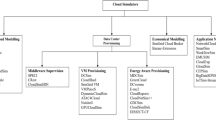Abstract
In our fast growing world, cloud computing took place and became a milestone in the new technology revolution. Cloud computing offers online services, wherever and whenever the user requests. The most leading companies such as Microsoft, Google, and Amazon have contributions to the development of this field and they offer their services to users, companies, and organizations by cloud computing. Because of the importance of cloud computing, maintaining the service sustainable and reliable is very important. This leads to high electrical power consumption and big emission of CO2. As a result, the concept of green cloud computing (GCC) has appeared and took the interest of service providers, researchers, and endusers. On the other hand, many algorithms have been developed to reduce power consumption and carbon emissions. In our paper, we simulate the efficiency of datacenters that use different algorithms for could computing (CC). In simulation, seven datacenters in different regions are used. There are seven users’ databases and these users make ten requests per hour, during a period of one year. During the process of simulation, we made tables of comparisons of the performance of algorithms to find out the best one to be used for GCC. Results show that the best algorithm for the GCC concept is the combination of the Round Robin Load Balancer Policy and ORT Broker Policy because it takes the least time response starting from sending requests until receiving the response.
Access this chapter
Tax calculation will be finalised at checkout
Purchases are for personal use only
Similar content being viewed by others
References
Radu, L. (2017). Green cloud computing: A literature survey. Symmetry, 9(12), 295. https://doi.org/10.3390/sym9120295.
Wickremasinghe, B. (2009). A CloudSim-based tool for modelling and analysis of large scale cloud computing environments (pp. 433–659, Rep.).
Nine, M. S., Azad, M. A., Abdullah, S., & Rahman, R. M. (2013). Fuzzy logic based dynamic load balancing in virtualized data centers. In 2013 IEEE International Conference on Fuzzy Systems (FUZZ-IEEE) (Vol. 1, pp. 1–7). https://doi.org/10.1109/fuzz-ieee.2013.6622384.
Author information
Authors and Affiliations
Corresponding author
Editor information
Editors and Affiliations
Rights and permissions
Copyright information
© 2021 The Author(s), under exclusive license to Springer Nature Switzerland AG
About this paper
Cite this paper
Qarqur, H., Sah, M. (2021). Simulation of Algorithms and Techniques for Green Cloud Computing Using CloudAnalyst. In: Favorskaya, M.N., Peng, SL., Simic, M., Alhadidi, B., Pal, S. (eds) Intelligent Computing Paradigm and Cutting-edge Technologies. ICICCT 2020. Learning and Analytics in Intelligent Systems, vol 21. Springer, Cham. https://doi.org/10.1007/978-3-030-65407-8_34
Download citation
DOI: https://doi.org/10.1007/978-3-030-65407-8_34
Published:
Publisher Name: Springer, Cham
Print ISBN: 978-3-030-65406-1
Online ISBN: 978-3-030-65407-8
eBook Packages: Intelligent Technologies and RoboticsIntelligent Technologies and Robotics (R0)




